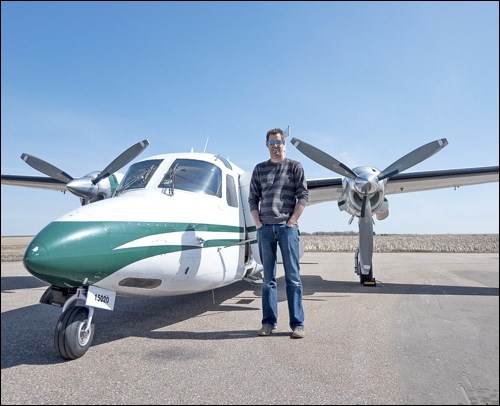MEADOW LAKE — Fire season has started here in Saskatchewan. April 28 was the day the Northern Aviation Operations for the Government of Saskatchewan at the Meadow Lake base was put on red alert due to the extremely dry conditions this spring.
The whole crew were ready to act at a moment's notice. Aircraft alerts can change from day to day and from area to area depending on the local fire conditions. During this day, Meadow Lake was on red alert, but other areas were not.
This reporter was in Meadow Lake to visit one of six tanker bases strategically located around the province. Corey Hardcastle, a pilot from Air Ronge, gave a tour of the Meadow Lake operation which includes a Convair 580-A air tanker and a TC 690 (Turbo Commander) “Bird Dog” aircraft. The tanker groups, including the Bird Dogs move around from base to base depending on the hazards and where they are most likely to be needed. The Meadow Lake base may not always have these aircraft during the season.
The Northern Aviation Operations has four land-based Convair 580-A aircraft that use fire retardant, as well as six Canadair CL-215 skimmer aircraft that can pick up water from bodies of water.
It takes only five minutes to load the 1,800 gallons of retardant on the plane. The Canadair CL-215 skimmer aircraftcarry about 1,200 gallons of water or foam.
Hardcastle, who has worked for Northern Aviation Operations for 11 years, is the pilot of the Bird Dog and acts as air traffic control over a wildfire. As soon as the aircraft is over a wildfire a restricted airspace zone of five nautical miles is declared andit is his responsibility to manage air traffic over the fire zone.
Seated beside Hardcastle is the air attack officer who is a fire expert and decides how to fight the fire in co-ordination with the crews on the ground. They assess the retardant drops and relay to the pilot what resources they need and where they are needed.
Hardcastle explained that although fire season can be any time, usually the season runs from April 1 to Oct. 31 each year. But because of the warm, dryer winter, one 580-A air tanker group started the last week in March.
So far this year, they have tackled a large fire near Big River, as well as another one southwest of Meadow Lake. He explained presently there are a number of grass fires or fires they would classify as “human” starts. However, as the grass greens and the trees bud the fire hazards may moderate. The hazards, and therefore number of fire starts, are dictated by many factors including precipitation, temperature, humidity, winds, type of fuel and, of course, sources of ignition.
Early season fires are almost all human-caused. However, when the thunder storms start to form, lightning becomes a major cause of forest fires. Usually at the end of the season tallying things up, fire starts are usually 50 per cent human and 50 per cent lightning.
His hope is that it isn’t as busy this summer and there won’t be a need for any of the evacuations seen last year.
When asked about flying over a fire, he responded, you always have to be careful. The operation is always concerned about the safety of the aircrews and if visibility gets to be under two miles, or if they feel unsafe, they will shut down the operation. As he explained, “two miles of visibility is our limit, you won’t want to be flying with less than that.”
The range of the aircraft flying out of Meadow Lake is approximately 200 miles, but there are times when the aircraft are required further afield and then their range is expanded if they can use another tanker base to fuel and reload retardant.
When asked if their duties are only in Saskatchewan, Hardcastle described how, through the Canadian Interagency Forest Fire Centre, Saskatchewan lends aircraft and crews to other provinces in event resources can be freed up to use elsewhere. This can include some of the western United States at times. Saskatchewan has wildfire resource-sharing agreements with other provinces and territories, several groups of U.S. states, the U.S. Forest Service, as well as several other international agreements.
During the winter, the planes are based at the headquarters for Aviation Operations in La Ronge where the aircraft are serviced and maintained. Hardcastle gave details about how each of the aircraft are basically taken apart and overhauled during the off-season.
When asked what he thought of his job, Hardcastle said he loved it. It allows him to be a stay-at-home dad during the winter months — which he valued. However, most times, summer vacations with the family are out of the question.




